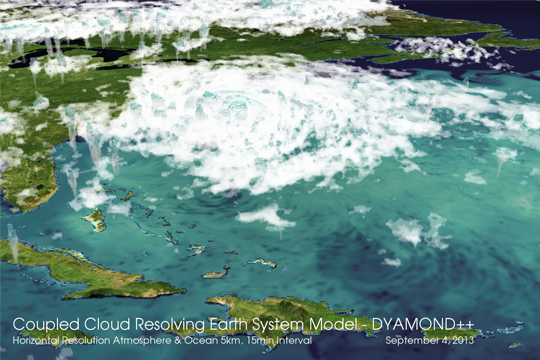29.10.2019
The GenR blog is funded by the Leibniz Association within the funding line strategic networks. It is meant as an online editorial platform for Open Science discourse across Europe. Anette Ganske and Angelina Kraft from AtMoDat were asked to provide a presentation of the AtMoDat project.
The full blog entry (https://doi.org/10.25815/X0BF-K589):
Atmospheric Models are a relevant element of Climate Research. They are e.g. part of Climate Models, which help to translate the scenarios for future increases of atmospheric greenhouse gas concentrations into possible changes of the earth system such as future changes in air temperature or sea level heights. The earth is a very complex chaotic system, where all components interact with each other, e.g. there are heat exchanges between the atmosphere and the ocean (Baede et al., 2001). Therefore, climate models consist of several submodels, e.g. for the atmosphere, the ocean or the land surfaces, which regularly exchange information during the simulations. The results of a climate simulation consist of a large number of variables (e.g. water temperature, humidity of the air, ocean currents, etc.) for which values are calculated over the entire earth and at several atmospheric and oceanic levels. Hence, a simulation of a climate model for a period of more than 100 years is very expensive and a lot of results for several variables are computed. Nevertheless, one simulation with a climate model only shows one possible physical outcome and the simulation with another climate model can lead to a different solution. For example, the timeline of the future warming of the atmosphere (or which part of the additional energy is stored in the atmosphere and in the ocean) differs if two simulations with different climate models are made. As a consequence, reports on climate change (e.g. the IPCC reports) always rely on the results of several models. Large internationally coordinated model comparison studies have been organized in order to assess this variability and uncertainty of climate models. The most recent study of this type is CMIP6 (Climate Model Intercomparison Project Phase 6, see Eyring et al., 2016). ![]()
Data format, quality and curation standards have been developed, to make climate model results intercomparable and to enable scientists all over the world to analyse the data (e.g. Taylor et al., 2018). This standardization actually is a precondition for successfully performing intercomparison studies such as CMIP6. The German Climate Computing Center (Deutsches Klimarechenzentrum, DKRZ) provides a high performance computing cluster for performing climate simulations and hosts one of the data centers, which store the data and provide them as open data for download to scientists and other interested persons. Each dataset is tested to comply with the established standards. At an appropriate level of granularity, all data receives a DataCite DOI (Digital Object Identifier) so that it can be uniquely identified and found.
Although standardization is very valuable when it comes to comparing model results, joint standards are not common for the data of all atmospheric modeling sub-disciplines for all their applications. As a result, the results of many atmospheric model simulations are not published as open data and are seldom used by other scientists. To increase the use of atmospheric model results, the project AtMoDat has been started in June 2019. It is carried out by the two infrastructure service providers, the Technische Informationsbibliothek (TIB), Leibniz Information Centre of Science and Technology, and the DKRZ, and by two research groups: the Meteorological Institute of the University of Hamburg and the Institute for Meteorology of the University of Leipzig.
The task of AtMoDat is to systematically adapt data curation standards inspired by the CMIP standard to the specific requirements of two research communities: small model comparison studies and urban climate research. Standards will be developed and applied to existing atmospheric model data and will be evaluated for their universal usability, which will significantly increase the reusability of these data. Based on these adapted standards, an extension of the DataCite metadata schema to domain-specific data will increase the value of DataCite DOIs as a quality feature. A sustainable application of the universal data standard as well as the allocation of subject-specific DataCite DOIs will be ensured by the service offers of the two infrastructure service providers TIB and DKRZ.
More information about AtMoDat can be found at https://www.atmodat.de/
Literature:
Eyring, V., Bony, S., Meehl, G. A., Senior, C. A., Stevens, B., Stouffer, R. J., and Taylor, K. E., 2016: Overview of the Coupled Model Intercomparison Project Phase 6 (CMIP6) experimental design and organization, Geosci. Model Dev., 9, 1937–1958, https://doi.org/10.5194/gmd-9-1937-2016
Baede, A.M.P; Ahlonsou, E.; Ding, Y. and Schimel, D, 2001: The Climate System: an Overview. In: Climate Change 2001: The Scientific Basis. Contribution of Working Group I to the Third Assessment Report of the Intergovernmental Panel on Climate Change [Houghton, J.T., Y. Ding, D.J. Griggs, M. Noguer, P.J. van der Linden, X. Dai, K. Maskell, and C.A. Johnson (eds.)]. Cambridge University Press, Cambridge, United Kingdom and New York, NY, USA, 881pp. https://www.ipcc.ch/site/assets/uploads/2018/03/TAR-01.pdf
Karl E. Taylor, Martin Juckes, V. Balaji, Luca Cinquini, Sébastien Denvil, Paul J. Durack, Mark Elkington, Eric Guilyardi, Slava Kharin, Michael Lautenschlager, Bryan Lawrence, Denis Nadeau, and Martina Stockhause, 2018. CMIP6 Global Attributes, DRS, Filenames, Directory Structure, and CV’s. Document Version v6.2.7. https://goo.gl/v1drZl
